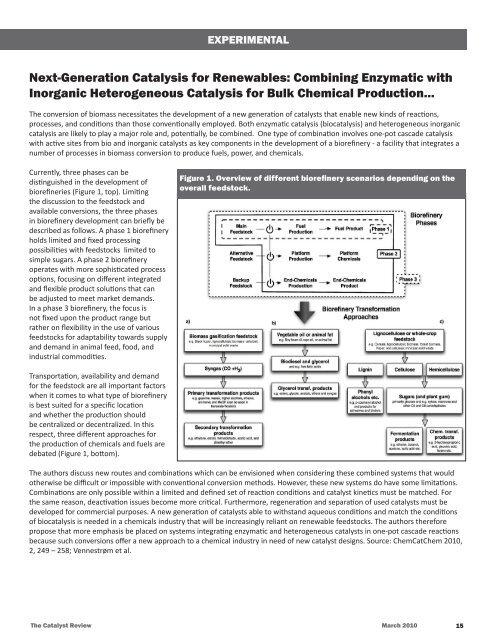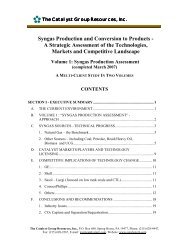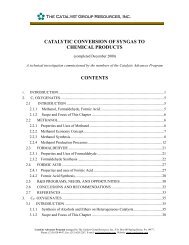THE CATALYST REVIEW - The Catalyst Group
THE CATALYST REVIEW - The Catalyst Group
THE CATALYST REVIEW - The Catalyst Group
You also want an ePaper? Increase the reach of your titles
YUMPU automatically turns print PDFs into web optimized ePapers that Google loves.
EXPERIMENTAL<br />
Next-Generation Catalysis for Renewables: Combining Enzymatic with<br />
Inorganic Heterogeneous Catalysis for Bulk Chemical Production...<br />
<strong>The</strong> conversion of biomass necessitates the development of a new generation of catalysts that enable new kinds of reactions,<br />
processes, and conditions than those conventionally employed. Both enzymatic catalysis (biocatalysis) and heterogeneous inorganic<br />
catalysis are likely to play a major role and, potentially, be combined. One type of combination involves one-pot cascade catalysis<br />
with active sites from bio and inorganic catalysts as key components in the development of a biorefinery - a facility that integrates a<br />
number of processes in biomass conversion to produce fuels, power, and chemicals.<br />
Currently, three phases can be<br />
distinguished in the development of<br />
biorefineries (Figure 1, top). Limiting<br />
the discussion to the feedstock and<br />
available conversions, the three phases<br />
in biorefinery development can briefly be<br />
described as follows. A phase 1 biorefinery<br />
holds limited and fixed processing<br />
possibilities with feedstocks limited to<br />
simple sugars. A phase 2 biorefinery<br />
operates with more sophisticated process<br />
options, focusing on different integrated<br />
and flexible product solutions that can<br />
be adjusted to meet market demands.<br />
In a phase 3 biorefinery, the focus is<br />
not fixed upon the product range but<br />
rather on flexibility in the use of various<br />
feedstocks for adaptability towards supply<br />
and demand in animal feed, food, and<br />
industrial commodities.<br />
Figure 1. Overview of different biorefinery scenarios depending on the<br />
overall feedstock.<br />
Transportation, availability and demand<br />
for the feedstock are all important factors<br />
when it comes to what type of biorefinery<br />
is best suited for a specific location<br />
and whether the production should<br />
be centralized or decentralized. In this<br />
respect, three different approaches for<br />
the production of chemicals and fuels are<br />
debated (Figure 1, bottom).<br />
<strong>The</strong> authors discuss new routes and combinations which can be envisioned when considering these combined systems that would<br />
otherwise be difficult or impossible with conventional conversion methods. However, these new systems do have some limitations.<br />
Combinations are only possible within a limited and defined set of reaction conditions and catalyst kinetics must be matched. For<br />
the same reason, deactivation issues become more critical. Furthermore, regeneration and separation of used catalysts must be<br />
developed for commercial purposes. A new generation of catalysts able to withstand aqueous conditions and match the conditions<br />
of biocatalysis is needed in a chemicals industry that will be increasingly reliant on renewable feedstocks. <strong>The</strong> authors therefore<br />
propose that more emphasis be placed on systems integrating enzymatic and heterogeneous catalysts in one-pot cascade reactions<br />
because such conversions offer a new approach to a chemical industry in need of new catalyst designs. Source: ChemCatChem 2010,<br />
2, 249 – 258; Vennestrøm et al.<br />
<strong>The</strong> <strong>Catalyst</strong> Review March 2010<br />
15






